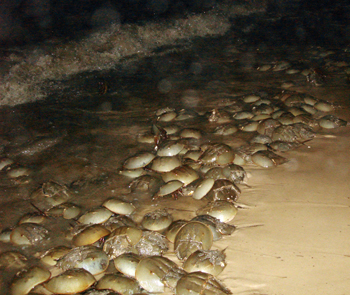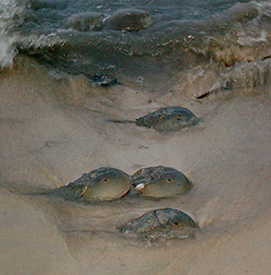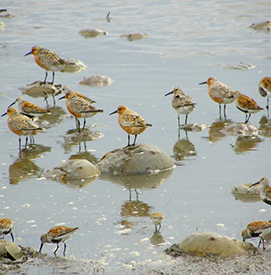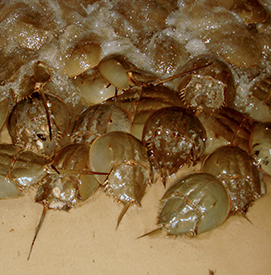Delaware • New Jersey • Pennsylvania
New York • United States of America
Horseshoe crabs, Limulus polyphemus, are benthic arthropods more closely related to spiders than crabs.
One of the oldest creatures on the planet, having been around for more than 300 million years, they inhabit both estuarine and continental shelf habitats stretching from the Yucatan Peninsula to Maine.
Importantly, the Delaware Bay is home to the largest population of spawning horseshoe crabs in the world. Spawning primarily occurs from mid-May to mid-June, usually coincides with the full and new moon high tides and is usually more prevalent at night.
Horseshoe crabs have historically supported a commercially important fishery, aided advancements in the biomedical industry and are an essential element of the Basin ecosystem and broader food web. Managed by the Atlantic States Marine Fisheries Commission (ASMFC), the current stock status for horseshoe crabs is good (2024).
Did You Know?
- Horseshoe crab eggs are an essential source of food for migratory birds, such as the red knot, which stop at the Delaware Bay on northward migrations.
 |
Every spring, usually starting in May, warming waters stir the crabs from the depths of the Delaware Bay and Atlantic Ocean to the sandy coastlines of Delaware and New Jersey.
At the high tides of the full and new moons, female horseshoe crabs come ashore to lay their eggs.
Waiting at the tide line, a male grabs hold of the female’s shell.
The female digs a shallow nest in the sand and lays up to 20,000 small, olive-green eggs. Next she drags the male over top to fertilize the eggs. Then they cover the eggs with sand and return to the water.
After two to four weeks, the 1/8 inch-long juvenile crabs hatch, dig to the surface, and head for the water. Feeding on tiny worms, clams and dead fish, the young crabs continue to grow and molt until they reach sexual maturity around 10 years of age. Females typically attain larger sizes than males. It is believed that they live up to approximately 20 years.
But, back on the beach, while many eggs hatch, others lay exposed, the waves at high tide having washed away much of the sand that covered them.
And, thousands of miles away another biological clock is ticking.
Red knots, ruddy turnstones, sanderlings, and semi-palmated sandpipers are already in flight, leaving behind their wintering grounds in Central and South America -- the mudflats of Surinam, the rocky nooks at Tierra del Fuego, the meadows on the Argentine Pampas.
They're winging some 7,000 miles towards the bay and the little green eggs which are now crucial to their survival. Depleted of fat reserves on arrival, many birds will almost double their body weight during their two-week stopover along the Delaware Bay.
They then depart on the next leg of their journey -- a 2,000-mile, non-stop flight to their Arctic breeding grounds.
By late June, the shorebirds will be nesting on the thawing tundra.
Because the Delaware Bay is the principal breeding grounds for American horseshoe crabs on the East Coast, it is also among the largest staging areas for shorebirds in North America.
And it is unique in that there's only one main course on the menu: the little green eggs.
Destroy the horseshoe crab's habitat and a vital link in the migratory chain would be broken, and thousands, perhaps millions, of shorebirds endangered.
- Flyer: Little Green Eggs (pdf)
- Flyer: Horseshoe Crabs (pdf)
Eyes and Skin
- Much of what we know about the human eye and how we see began over 50 years ago with studies of the horseshoe crab's large, compound eye.
- Researchers have also studied the horseshoe crab's chitin, a cellulose-like compound in its shell; chitin, when coated on sutures and burn dressings, increases healing time.
Detecting Toxicity & Cancer
- Most importantly, in the 1960s, it was discovered that the horseshoe crabs' copper-based, blue blood contains a special clotting agent which attaches to bacterial toxins.
- Today, Limulus Amebocyte Lysate (LAL), which is manufactured from horseshoe crab blood, has become the worldwide standard screening test for bacterial contamination.
- Every intravenous drug, vaccine and surgical implant, such as pacemakers and prosthetic devices, must be tested using LAL.
- Horseshoe crab blood has recently been found to be useful in cancer research as well.
Harvesting Blood from Horseshoe Crabs
- Blood from horseshoe crabs is obtained by collecting adult crabs, extracting a portion of their blood, and releasing them alive. Following bleeding, most crabs are returned to near the location of their capture.
- It is estimated that over 400,000 crabs are harvested annually for biomedical purposes, and the estimated crab mortality during and after the bleeding process is anywhere from 10-30%.
- Scientists are researching whether a synthetic substitute can be used as a viable alternative.
 |
 |
 |
| Horseshoe crabs riding the waves to shore. Photo by DRBC. |
The life cycles of horseshoe crabs and red knots are closely connected. Photo by Mark Binder. |
Horseshoe crabs crowd a New Jersey beach in May. Photo by DRBC. |
About the Horseshoe Crab
- Atlantic States Marine Fisheries Commission
- Conserve Wildlife NJ: Horseshoe Crab
- The Horseshoe Crab - Natural History, Anatomy, Conservation and Current Research
- National Wildlife Federation: Horseshoe Crab
- NOAA: The Remarkable Horseshoe Crab
- NOAA: Are Horseshoe Crabs really Crabs?
- Sea Grant Delaware: Horseshoe Crab Research
Crabs and Shorebirds
- Birds and Crabs (National Public Radio, June 2002)
- Delaware Birding Trail
- Delaware Museum of Natural History: Shorebirds & Feast on the Beach
- PBS NATURE: "Crash: A Tale of Two Species" (PBS, February 2008)
- Delaware Division of Fish & Wildlife Shorebird Project
- New Jersey Audubon Society's Cape May Bird Observatory
- New Jersey Division of Fish & Wildlife Delaware Bay Shorebirds
- Partnership for the Delaware Estuary's "Horseshoe Crab and Shorebirds" Fact Sheet (pdf)
- U.S. Fish and Wildlife Service - Shorebirds, The Delaware Bay Connection (pdf)
- Shorebird Sister Schools Program (A U.S. Fish and Wildlife Service program linking schools, biologists & shorebird enthusiasts along flyways)
Volunteer Opportunities
Copyright © Delaware River Basin Commission,
P.O. Box 7360, West Trenton, NJ 08628-0360
Phone (609)883-9500; Fax (609)883-9522
Thanks to NJ for hosting the DRBC website